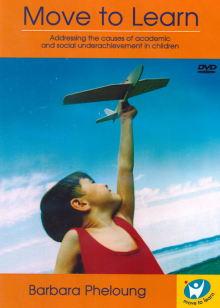
What do I need to run the Move to Learn program?
The DVD, Move to Learn, is designed to enable a parent, teacher or helper to run the Move to Learn program with a class or an individual child.
Each of the Movement Sequences is clearly demonstrated in an easy-to-follow-along-with manner and all important information is included.
The booklet, Ten Gems for the Brain, explains the program in simple English with lots of diagrams. It is also be easy to follow. It doesn’t explain why the program works, or provide the same depth of detailed information that the books provide, but it does explain how to do the program, and it is all you should need to run the program.
I am a teacher, can the Move to Learn program be done in my classroom?
Yes, definitely. The Move to Learn program is a simple, flexible program. It requires no equipment, and little space. You need only to move the desks aside to give each child space to lie on the floor. Alternatively, multi purpose rooms can be used, or the program could be run in the school yard on mats.
All you need is a copy of the DVD, Move to Learn or the e-booklet, Ten Gems for the Brain to understand how to implement the program.
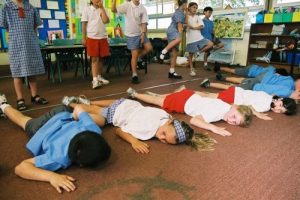 Facilitators need little training or preparation and you only need to set aside 15-20 minutes a day. The sequences should be done daily, (or at least 5 days a week).
Facilitators need little training or preparation and you only need to set aside 15-20 minutes a day. The sequences should be done daily, (or at least 5 days a week).
The program is suitable and beneficial for the whole class, including those who don’t appear to be struggling with learning. Research suggests there is usually a marked increase in focus and a decrease in behavioural problems in classrooms where the program has been used.
Some children may need further individual work or specialist treatment to address their problems fully, and the program will help to identify those children
In my class, some of the children grasp the movements quickly, while others are slower. How should I deal with this?
The program is actually very useful as a tool to identify children who are struggling and need further help. If a child is struggling and unable to keep up with the class, it may be possible that they could benefit from further investigation into their difficulties. Referral to other professionals, such as an audiologist, allergy specialist, behavioural optometrist etc., may be appropriate.
The slower ones (with the cooperation of their parents) should also be encouraged to do the exercises at home as well (with the aid of the booklet, Ten Gems for the Brain or the DVD).
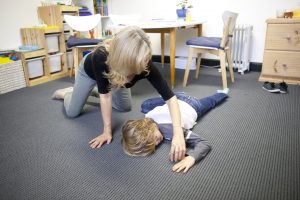 Do the exercise until the majority of the class is able to do it properly, and then move on to the next exercise. It won’t hurt the slower ones to attempt the more difficult exercises along with the rest of the class, provided they are encouraged and not marked as failing. They will still need to work through the exercises separately at their own pace for full effect for them however.
Do the exercise until the majority of the class is able to do it properly, and then move on to the next exercise. It won’t hurt the slower ones to attempt the more difficult exercises along with the rest of the class, provided they are encouraged and not marked as failing. They will still need to work through the exercises separately at their own pace for full effect for them however.
The faster children can be given extra challenges to keep them interested, and it often works really well to have them work with the slower ones as teacher’s aides.
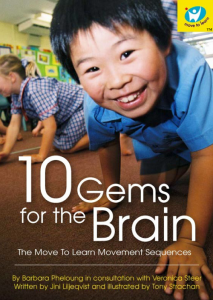 What equipment is needed to get started?
What equipment is needed to get started?
All you need to run the program is the Move to Learn DVD, a DVD player, a TV and some floor space. Alternatively, in stead of the DVD, you could use the booklet, Ten Gems for the Brain.
Are the movements suitable for all ages including adults?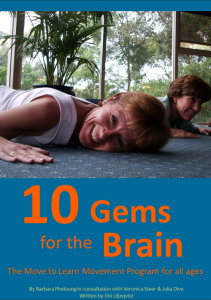
Yes, they are. Based on the natural movements of babies and toddlers, they are effective for all ages. You can learn more about that here. Our new e-book; Ten Gems For The Brain; The Move To Learn Movement Program For All Ages is a great guide for teens, adults and seniors!
Does this program help address primitive reflexes?
Close links have been identified between the inhibition of primary reflexes and the attainment of gross-motor milestones. Reflexes are often used as landmarks and measurements of CNS maturity. They play a vital role in survival for crucial periods but should then undergo inhibition or transformation. If this doesn’t happen, Neuro-Developmental Delay, (the continued presence of a cluster of Primitive Reflexes above the age of 6 months (12 months at the latest), in combination with absent or under-developed Postural Reflexes above three and a half years of age) will often result. Some signs of neuro-developmental delay are:
- Poor concentration
- Emotional presentation
- Poor impulse control
- Weak balance and motor skills
- Weak posture, sitting position
- Weak academic performance, organisation of work, copying from board
Obviously, these things will have a major impact on academic learning.
The Move to Learn program has included the inhibition of persistent primary reflexes as a core element in its program, addressing the underlying functional deficits that children with various difficulties have shown. The 10 simple movement sequences cover all the essentials that every child needs, and in the right order.
My child is a teenager, and desperately needs help, is the Move to Learn Program too young for him?
Certainly not. Many adults have done the program with great success. It usually works best for teenagers and adults if they are involved in their own assessment. They can watch for and record improvements. Taking a leadership role, perhaps demonstrating for others or leading groups of younger children, can be a good motivator for teens – as can bribery!
We have developed a separate version of our program for teens & adults – Ten Gems For The Brain; The Move To Learn Movement Program For All Ages.
I am an adult, will the program work for me?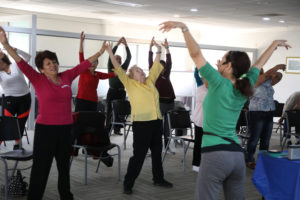
Many adults have done the program with great success. It is particular with seniors. It usually takes a little longer the older you are, the optimum time for these movements is during the pre-school years, but improvement should be possible with patient persistence. For further guidance, read our e-book, Ten Gems For The Brain; The Move To Learn Program For All Ages.
Do I need to buy a franchise or pay an authorisation to use the program in my school?
We don’t put restrictions on where the program can be used, but what we do ask is that the copyright is respected.
We ask that our work isn’t photocopied, cut-and-pasted into other works, translated or reproduced in any other way without our express permission, as income from the books & DVD is our only source of income.
In universities and teachers’ colleges, we don’t ask for a fee to include the program on the curriculum but we do ask that each student purchase a copy of our DVD and at least one of our books, and that copies of all the books are made available in the University Library.
Again, no photocopying or reproducing.
We don’t sell franchises or offer exclusive territories because we want everyone to be able to use the program as freely as possible.
